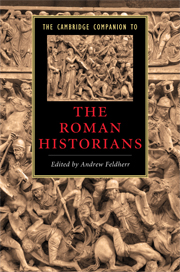Book contents
- Frontmatter
- Introduction
- Part I Approaches
- Part II Contexts and Traditions
- Part III Subjects
- Part IV Modes
- 12 The rhetoric of Roman historiography
- 13 The exemplary past in Roman historiography and culture
- 14 Intertextuality and historiography
- Part V Characters
- Part IV Transformations
- Chronological list of the historians of Rome
- Bibliography
- Index
13 - The exemplary past in Roman historiography and culture
from Part IV - Modes
Published online by Cambridge University Press: 28 November 2010
- Frontmatter
- Introduction
- Part I Approaches
- Part II Contexts and Traditions
- Part III Subjects
- Part IV Modes
- 12 The rhetoric of Roman historiography
- 13 The exemplary past in Roman historiography and culture
- 14 Intertextuality and historiography
- Part V Characters
- Part IV Transformations
- Chronological list of the historians of Rome
- Bibliography
- Index
Summary
The modern reader of any Roman text that concerns itself with the Roman past - principally, but not only, narrative historiography - is inevitably struck by the prominence accorded “great deeds” and the actors who perform them. It is a familiar feature of Roman historical consciousness that, at any given time, the past could be regarded as a storehouse of practices, orientations, and values - sometimes referred to as the mos maiorum, “the custom of the forebears” - that were embodied in celebrated actors and deeds, and through them were made manifest and accessible to later ages. These actors and deeds could be adduced as cognitive or ethical models to provide guidance and standards to later Romans as they contemplated actions of their own, or evaluated the actions of others. These paradigmatic actors and deeds from the past are my subject here, and I aim to examine the consequences, for historiography and other commemorative forms, of regarding the past as “exemplary” in this way. I begin by distinguishing the “exemplary” mode of confronting the past from the “historicist” modes that have characterized the academic discipline of history since the early nineteenth century. I then explore the ways exemplarity manifests itself in Roman culture generally (the broader context in which the specifically historiographical manifestations occur) by examining the case of Gaius Duilius, consul in 260 BCE, who was renowned for a naval victory over the Carthaginians. I conclude by considering to what extent, in Duilius' case and more generally, “historicist” elements can be identified alongside the “exemplary” ones in Roman historical consciousness.
- Type
- Chapter
- Information
- The Cambridge Companion to the Roman Historians , pp. 214 - 230Publisher: Cambridge University PressPrint publication year: 2009
- 23
- Cited by

